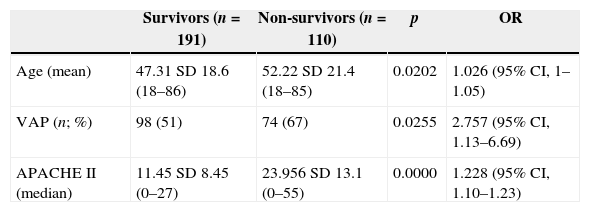The US Food and Drug Administration (FDA) have issued a warning describing increased mortality risk associated with the use of tigecycline when compared to other drugs in the treatment of serious infections. Such increased risk was determined using a pooled analysis of randomized clinical trials which involved predominantly patients treated for ventilator-associated pneumonia (VAP).1
In the present observational and retrospective study, we determined the mortality predictor factors between survivors and nonsurvivors patients treated with tigecycline. Patients were enrolled in the study at 23 Latin American centers between February 2006 and June 2009. Data collection from clinical records was done using an electronic form (LatinUser® website; http://www.clinicalrec.com.ar). Two tailed hypothesis testing for difference in proportions and multivariable logistic regression to identify predictors of mortality were used for analysis.
Of the 301 eligible patients, 208 patients were male and the mean age was 49.7 (range 18–86). The overall in-hospital mortality was 36.5% (110/301 nonsurvivors vs 191/301 survivors). Univariate analysis showed that age, hospitalization in intensive care unit, APACHE II score, VAP, microbiological documentation, previous use of carbapenems and, immunocompromise were significantly associated with mortality. The multivariate analysis showed that only age [odds ratio (OR): 1.026; [95% CI 1–1.05], p=0.0202]; VAP (OR: 2.757; [95% CI 1.13–6.69], p=0.0255) and APACHE II score (OR: 1.228; [95% CI 1.10–1.23], p=0.0000) were identified as independent risk factors for mortality (Table 1).
Multivariate analysis of factors associated with mortality in patients treated with tigecycline.
| Survivors (n=191) | Non-survivors (n=110) | p | OR | |
|---|---|---|---|---|
| Age (mean) | 47.31 SD 18.6 (18–86) | 52.22 SD 21.4 (18–85) | 0.0202 | 1.026 (95% CI, 1–1.05) |
| VAP (n; %) | 98 (51) | 74 (67) | 0.0255 | 2.757 (95% CI, 1.13–6.69) |
| APACHE II (median) | 11.45 SD 8.45 (0–27) | 23.956 SD 13.1 (0–55) | 0.0000 | 1.228 (95% CI, 1.10–1.23) |
VAP, ventilator associated pneumonia.
In concordance with the FDA warning, our study shows that in-hospital mortality with tigecycline was significantly higher in critically ill patients with VAP. Undoubtedly, from a strictly scientific point of view, there is no evidence to support tigecycline use in these patients. In that sense, Freire et al. reported significantly lower cure rates in clinically evaluable patients with VAP treated with tigecycline (47.9%) when compared to imipenem (70.1%) (−22.2% [95% CI lower limit, −39.5%]). Based on these results, tigecycline has not been approved by the FDA for the treatment of VAP.2
Considering the attainable extracellular epithelial lining fluid concentrations of tigecycline (0.37μg/mL), the current dosage of 50mg of tigecycline twice daily is probably underdosed for the treatment of VAP caused by typical, extracellular-acting bacteria such as Acinetobacter spp (MIC90∼1μg/mL).3
Regardless of these issues, the tigecycline pharmacological and microbiological profiles encourage physicians to use the drug for VAP due to multidrug-resistant (MDR)-pathogens. In that respect, we have published that more than 50% of the tigecycline prescriptions in Argentina were for VAP, mainly due to MDR-Acinetobacter spp.4 This practice is justified by the high regional resistance rates of MDR-pathogens with limited therapeutic options (e.g. carbapenem-resistant Acinetobacter spp.; KPC-producing Enterobacteriaceae).
We know that clinical trials are indispensable tools to generate new knowledge and to test therapeutic options for the care mainly of critically ill patients, however, the epidemiological situation usually force physicians to incorporate the off-label use of some antibiotics as part of their daily practice (e.g. polymyxins, fosfomycin, sulbactam and other antibiotics, alone or in combinations).
In the specific case of tigecycline it is mandatory to conduct clinical trials to generate comparative evidence about tigecycline efficacy and safety in VAP using higher doses (i.e. 200mg initial and 100-q12), as well as to determine the role of tigecycline combinations with other antibiotics (carbapenems, polymyxins, and fosfomycin among others).
Observational studies although helpful, are generally not adequate to address these issues, and controlled clinical trials will be necessary to provide sufficient and reliable evidence to support approval for new tigecycline indications and dosing schedules. Nevertheless, this process usually takes several years.
For the treatment of serious or life-threatening illness, FDA regulations, issued in 1992, allow for “accelerated approval” of a drug or biologic product that provides a “meaningful therapeutic benefit. over existing treatments”.5 Assuming the serious infections due to MDR-pathogens as a considerable unmet medical need, this type of programs may help to get new scientific evidence of tigecycline in a shorter time in order to improve our patients’ clinical outcome.
Conflict of interestThe author is a speaker for Pfizer Argentina (formerly Wyeth SA).





